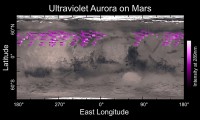Artist’s conception of MAVEN’s Imaging UltraViolet Spectrograph (IUVS) observing the “Christmas Lights Aurora” on Mars. MAVEN observations show that aurora on Mars is similar to Earth’s “Northern Lights” but has a different origin. (University of Colorado)
Home Artist’s conception of MAVEN’s Imaging UltraViolet Spectrograph (IUVS) observing the “Christmas Lights Aurora” on Mars. MAVEN observations show that aurora on Mars is similar to Earth’s “Northern Lights” but has a different origin. (University of Colorado) Artist’s conception of MAVEN’s Imaging UltraViolet Spectrograph (IUVS) observing the “Christmas Lights Aurora" on Mars. MAVEN observations show that aurora on Mars is similar to Earth’s "Northern Lights" but has a different origin. (University of Colorado)



